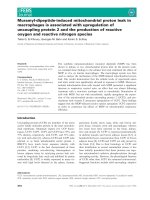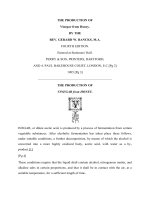The Production of Ethanol from Maize Cobs and Groundnut Shells docx
Bạn đang xem bản rút gọn của tài liệu. Xem và tải ngay bản đầy đủ của tài liệu tại đây (86.22 KB, 5 trang )
AU J.T. 9(2): 106-110 (Oct. 2005)
The Production of Ethanol from Maize Cobs and Groundnut Shells
U.G. Akpan, A.S. Kovo, M. Abdullahi, and J. J. Ijah*
Department of Chemical Engineering, Federal University of Technology
Minna, Nigeria
Abstract
The possibility of producing ethanol from biomass such as maize cobs and
groundnut shells was investigated. Different concentrations of sulphuric acid (H
2
SO
4
)
were used to determine the acid concentration that could produce an optimal yield of
glucose. The results revealed that 4.5M H
2
SO
4
produced the optimal yield of glucose
and ethanol. This acid concentration was then used for the study of temperature effects
on yield of glucose. The results indicated that glucose yield increased with temperature
within the experimental set-up. The maize cobs and groundnut shells were mixed at
various ratios and pretreated to remove all extractives. The ratio of 3:1 of maize cobs
to groundnut shells and at 4.5M acid gave a better glucose yield than those obtained
from individual biomass. The ultimate product (glucose) was hydrolyzed and 8%
ethanol was obtained within three hours.
Keywords: Alcohol, glucose, biomass, hydrolysis, fermentation.
Introduction
The rapid growth of industries and
technological advancement in the world call for
development in the chemical sector. The
production of industrial chemicals will enhance
the economic progress of any nation. Ethanol,
one of the important industrial chemicals, can
be produced extensively from biomass such as
maize cob and groundnut shell. The main
constituents of this class of crop by-product are
cellulose (Chang, et al. 1981) and
hemicelluloses, making them lignocelluloses
(Cowling 1976) that can be excellent energy
sources.
The practice of mechanized farming has
led to extensive discharge of agricultural
wastes that have had negative effects on the
environment. The utilization of such wastes has
been a source of concern to many researchers
(Oyenuga 1959; Akpan 1999; Amosun 2000).
Therefore, this work was designed to look into
the possibility of converting some of such by-
products into industrial chemicals of economic
importance. Ethanol is one such chemical. It is
* Department of Biological Sciences, Federal
University of Technology, Minna, Nigeria
used as a solvent for chemicals. Ethanol is used
as an intermediate in the production of liquid
detergents. It is also used in the manufacture of
drugs, plastics, polishes, plasticizers, perfumes,
cosmetics, rubbers, accelerators, and cellulose
nitrate. It is further used as an anti-freeze.
Ethanol produced from regenerable sources is
an attractive petrochemical feedstock in
petroleum for poor countries (Gordon, et al.
1979). The various uses of ethanol and the
importance of ridding the environment of the
harmful effects of these agricultural by-
products (biomass) underscore the significance
of this work.
Ethanol is produced from palm wine by
fermentation process (Harris 1963).
Fermentation is one of the oldest processes
known to man, and it is used in making a
variety of products including foods, flavorings,
beverages, pharmaceuticals, and chemicals.
Ethanol is made from a variety of products
such as grain, molasses, fruit, cobs, and shell;
its production, excluding that of beverages, has
been declining since the 1930s because of the
low cost (Othman 1981). In 1975, only
76×10
6
L of proof industrial ethanol were
produced by fermentation compared to
7.95×10
6
L by synthesis.
106
AU J.T. 9(2): 106-110 (Oct. 2005)
During 1974, Nigeria was spending N 2
million annually on spirits and alcohol
(Madrella, et al. 1981). This expenditure
represents a big market for a country like
Nigeria, with a population of over 120 million
people. A crude estimate of the total market for
alcoholic beverages in Nigeria is about
2,500,500 L/year. Therefore, provision must
be made to balance the shortfall to complement
the imported, hence the need for this work.
Neverthless, the production of chemical
feedstock from biomass making use of locally
sourced material that is very cheap and within
reach can be accomplished (Eweke, et al.
1979). In this work, agricultural wastes, which
are readily available, were used for ethanol
production.
Methodology
Collection and Processing of Substrate Used
Maize cobs and groundnut shells were
collected in polythene bags from the farm of
Government Technical School, Kontagora,
Niger State, Nigeria and transported to the
laboratory. A serrated disc grinder was used to
reduce the maize cobs and groundnut shells
into very small sizes of particle. These particles
were then sieved to obtain average particle
sizes of 300μm in diameter. The cellulose was
isolated by the procedure described by
Layokun (1981). To 10g of each sample of the
agricultural waste was added 20ml of diethyl
ether in a 250ml Erlenmeyer flask in order to
remove extractives and the residue left was
washed with distilled water. 20ml of 14M
H
2
SO
4
was added to the residue to isolate
lignin. The hemicelluloses and cellulose were
dissolved leaving lignin as a hard precipitate.
This modified procedure described by Layokun
(1981) was used to isolate the sample of maize
cobs and groundnut shells individually. This
procedure was repeated for mixture of both
samples in the ratio 1:1, 1:2, 1:3 and 3:1 in
order to obtain best mixture that could produce
high quality of ethanol.
To determine the effect of different acid
concentrations on the hydrolysis 2M solution
of concentrated H
2
SO
4
was prepared and 10g of
the leached maize cobs and groundnut shells
were added to 50ml of the 2 M solution of
H
2
SO
4
, respectively under room temperature in
a stirred 250ml conical flask which serve as a
reactor. This reaction was allowed to proceed
for 2.5 hrs. Some quantities of the hydrolyzed
sample at an interval of 30 min was collected
and filtered, the resulting filtrates analyzed for
the glucose using a refractometer (Abbe 60).
The entire procedure was repeated for
3M, 4M, 4.5M and 5M of H
2
SO
4
and the
various acid concentrations recorded. Using the
best concentration of H
2
SO
4
(4.5M), a mixture
of maize cobs and groundnut shells in the ratio
of 1:1, 1:2, 2:1, 1:3 and 3:1 were leached and
the hydrolyzed samples were filtered. The
resulting filtrate was analyzed for glucose and
the best ratio determined.
Using the best maize cobs to groundnut
shells of 3:1, the effect of temperature on its
hydrolysis was investigated using a
thermostated water bath (Gallenkamp,
England) at 40
o
, 50
o
, 60
o
, 70
o
and 80
o
C 4.5M
H2SO4 was used for the hydrolysis, and 10g of
the mixture were pretreated by a modified
procedure described by Layokun (1981). The
reaction was allowed to proceed for 2.5 at
constant temperature.
The resulting hydrolyzed sample was
filtered leaving a filtrate with high percentage
of glucose and this acted as the substrate. The
substrate in the fermentation medium was
inoculated with S. cerevisiae as the started
culture and the time noted. The conical flask,
which has been sterilized, was tightly sealed
with glass stopper to avoid air entering the
reactor medium. The entire process was
allowed to remain for three hours. Every 30
minutes, a sample was withdrawn and both
glucose and the ethanol concentration were
determined using a refractometer.
In order to obtain a large quantity of pure
ethanol, the quantity of maize cobs and
groundnut shells were increased using the same
ratio (3:1). The entire hydrolysis process was
carried out to produce large quantity of
glucose, which was fermented simultaneously.
After the fermentation process, alcohol
was recovered using a simple batch distillation
method. Confirmatory tests were carried out to
ascertain that the distillate was actually
ethanol.
107
AU J.T. 9(2): 106-110 (Oct. 2005)
Results and Discussion
Acid hydrolysis of maize cobs and
groundnut shells at different acid
concentrations and at ambient temperatures
showed an increase in glucose concentration
with time (Tables 1 and 2). The concentration
of glucose was higher for both biomass when
the concentration of 4.5M H
2
SO
4
was used.
The glucose yield of maize cobs was higher
than that of groundnut shells, and ranged from
0 to 0.89g/cm
3
for maize cobs (Table1) and 0
to 0.53g/cm
3
for groundnut shells (Table2)
Table 1. Glucose yields for acid hydrolysis of
maize cobs at ambient temperature using
different acid concentrations
Glucose yield (g/cm
3
Time
[min]
2M
a
3M
a
4M
a
4.5M
a
5M
a
0
6
12
18
30
60
90
120
150
0
0.02
0.07
0.15
0.21
0.33
0.39
0.42
0.43
0
0.03
0.11
0.19
0.24
0.34
0.41
0.46
0.48
0
0.04
0.14
0.20
0.26
0.42
0.53
0.60
0.64
0
0.05
0.17
0.28
0.46
0.67
0.79
0.86
0.89
0
0.02
0.13
0.26
0.35
0.49
0.57
0.60
0.02
a = acid concentration
Table2. Glucose yields for acid hydrolysis of
groundnut shells at ambient temperature
using different acid concentrations
Time Glucose yield (g/cm
3
)
(min) 2M
a
3M
a
4M
a
4.5M
a
5M
a
0
6
12
18
30
60
90
120
150
0
0.01
0.04
0.06
0.10
0.17
0.23
0.28
0.34
0
0.02
0.05
0.08
0.13
0.21
0.28
0.36
0.37
0
0.03
0.06
0.10
0.17
0.29
0.36
0.40
0.43
0
0.04
0.07
0.14
0.28
0.37
0.43
0.49
0.53
0
0.05
0.09
0.15
0.23
0.37
0.45
0.45
0.46
a = acid concentration
There was a drop in glucose
concentration for both biomasses when
hydrolyzed at 5M H
2
SO
4
. This could be
attributed to the fact that at a higher
concentration of acid, glucose can be converted
to levulinic and formic acid (Ghose 1956),
which leads to decrease in glucose yield. These
then suggest that highest glucose yield can be
obtained at moderate acid concentration of
4.5M H
2
SO
4
, which also serves as the optimal
pH condition for yeasts to metabolize its
substrate (Fan, et al. 1980; Adams and Moses
1995).
Acid hydrolysis of maize cobs and
groundnut shell at varying temperature using
the optimal acid concentration of 4.5M H
2
SO
4
brought about increase in glucose yield with
time as shown in Tables 3 and 4.
Tables 3. Glucose yields for acid hydrolysis of
maize cobs at varying temperatures using
4.5M H
2
SO
4
Glucose yield (g/cm
3
) Time
(min)
40
o
C50
o
C 60
o
C 70
o
C80
o
C
0
6
12
18
30
60
90
120
150
0
0.11
0.30
0.50
0.71
0.73
0.75
0.78
0.80
0
0.15
0.35
0.61
0.73
0.74
0.76
0.78
0.83
0
0.21
0.50
0.65
0.74
0.78
0.79
0.82
0.85
0
0.35
0.62
0.81
0.76
0.80
0.83
0.84
0.87
0
0.43
0.67
0.85
0.87
0.93
0.95
0.97
0.98
Table 4. Glucose yield for acid hydrolysis of
groundnut shells at varying temperatures
using 4.5M H
2
SO
4
Glucose yield (g/cm
3
) Time
(min)
40
o
C50
o
C 60
o
C 70
o
C80
o
C
0
6
12
18
30
60
90
120
150
0
0.09
0.20
0.31
0.42
0.42
0.43
0.44
0.45
0
0.11
0.23
0.34
0.44
0.45
0.47
0.48
0.49
0
0.14
0.30
0.40
0.45
0.47
0.49
0.50
0.51
0
0.19
0.35
0.43
0.49
0.50
0.51
0.52
0.53
0
0.21
0.38
0.47
0.52
0.54
0.55
0.56
0.63
108
AU J.T. 9(2): 106-110 (Oct. 2005)
At 80
O
C, glucose yield for both biomass
was at the peak and ranged 0 - 0.98g/cm
3
for
maize cobs and 0 - 0.63g/cm
3
for groundnut
shells. This indicates that, at higher
temperatures and at moderate acid
concentrations, the yield of glucose increases.
Consequently, acid hydrolysis of a mixture of
maize cobs and groundnut shells at different
ratios using 4.5 M H
2
SO
4
at ambient
temperature shows an increase in glucose yield
as shown in Table 5.
Table 5. Glucose yield for acid hydrolysis for
mixture of maize cobs and groundnut shells
using 4.5M H
2
SO
4
at ambient temperature
Glucose yield (g/cm
3
) Time (min)
1:1 1:2 2:1 1:3 3:1
0
6
12
18
30
60
90
120
150
0
0.05
0.13
0.23
0.36
0.54
0.65
0.71
0.75
0
0.04
0.10
0.19
0.25
0.39
0.49
0.55
0.58
0
0.09
0.17
0.33
0.43
0.63
0.75
0.83
0.86
0
0.01
0.04
0.06
0.14
0.23
0.31
0.35
0.36
0
0.12
0.22
0.36
0.51
0.73
0.86
0.89
0.94
The ratio 1: 3 (maize cobs, groundnut
shells) shows a drastic decrease in glucose
yield from 0to0.36g/cm
3
when compared to
other ratios. This is probably due to high
amount of groundnut shells with structures,
which contain high degree of crystallinity and
polymerization thereby, limit accessibility to
acid attack. Ratio 3:1 of maize cobs and
groundnut shells and 4.5M H
2
SO
4
at varying
temperature shows an increase in glucose yield,
as shown in Table 6. Though glucose yield
increases with temperature, it is important to
note that it may denature at temperature above
its boiling point. Therefore, the experiment
above 80
o
C will not be advantageous.
During fermentation, the amount of
ethanol produced and glucose used were
determined and the results are shown in Table
7. The ethanol in the product increased from 0
to 8.2, while that of glucose decreased from
1.53g/cm
3
to 0.07g/cm
3
after 2.5 hours of the
fermentation. The increase in ethanol
production and decrease in the amount of
glucose is due to the fact that, during
fermentation the yeast (S. ceresiae) utilized the
glucose as a source of carbon and energy,
whereas ethanol is produced as a result (Nester,
et al. 1995). A test was carried out using
iodoform and dichromate solution confirmed
that the distillate was ethanol.
Table 6. Glucose yield for hydrolysis for
mixture of maize cobs and groundnut
shells in ratio 3:1 using 4.5M H
2
SO
4
at
different temperatures
Glucose yield (g/cm
3
) Time
(min)
40
o
C50
o
C 60
o
C 70
o
C80
o
C
0
6
12
18
30
60
90
120
150
0
0.03
0.28
0.56
0.83
0.85
0.86
0.88
0.90
0
0.10
0.40
0.62
0.86
0.89
0.90
0.92
0.93
0
0.25
0.58
0.68
0.90
0.92
0.95
0.96
0.97
0
0.28
0.62
0.76
0.93
0.95
0.98
1.00
1.01
0
0.31
0.65
0.94
1.07
1.25
1.29
1.43
1.53
Table 7. Percentage of ethanol produced and
glucose concentration
Time
(h)
Specific
gravity
Ethanol
(%)
Glucose
concentration
(g/cm
3
)
0
0.5
1.0
1.5
2.0
2.5
3.0
1.00
1.008
1.014
1.021
1.028
1.038
1.043
0
0.6
2.6
3.8
4.7
8.2
8.0
1.53
1.32
1.16
1.10
0.93
0.68
0.06
Conclusion
The results obtained from the experiment
reveal that glucose is present in a reasonable
amount in maize cobs and groundnut shells
mixed together in the ratio 3:1. If the product
(glucose) is fermented under the stipulated
experiment conditions with Saccaharomyces
cerevisiae (baker’s yeast), a substantial amount
of ethanol, which is used as a chemical
feedstock, will be produced. Thus, the
109
AU J.T. 9(2): 106-110 (Oct. 2005)
importation of ethanol can be reduced if
substantial energy is devoted to the production
of ethanol from biomass. This will also have a
multiplier effect such as jobs for the
unemployed.
References
Adams, M.R.; and Moss, M.O. 1995. Food
Microbiology. Royal Society of Chemistry,
Cambridge, UK, pp. 252-5.
Akpan, U.G. 1999. Acid demethylation of
agricultural waste (citrus peel). Paper
presented at the 8
th
Annual Sci. Conf.
Nigeria Society for Biol. Conserv.,
University of Uyo, Uyo Nigeria.
Amosun, A.O. 2000. Gasification of biomass
for methanol production. An unpublished
B.Eng. Chemical Engineering Dept., Federal
Univ. of Technology, Minna, Nigeria.
Chang, M.M.; Chou, J.Y.; and Tsao, G.T.
1981. Structure, pretreatment and hydrolysis
of cellulose. Adv. Biochem. Engin. 16: 40-5.
Cowling, E.B. 1976. Physical and chemical
constraints in the hydrolysis of cellulose and
lignocellulose’s material. Biotech. Bioengin.
Symp. Series 5:163-81.
Ghose, T.K. 1956. Cellulose biosynthesis and
hydrolysis of cellulosic substances.
Adv. Biotech J. 2: 105-11.
Gordon, G.B.; and Michael, S. 1979. Food
Science. pp. 21, 37-97. Pergamon Int.
Popular Sci. Series, Oxford, UK.
Harris, J.F. 1963. Wood as a Chemical Raw
Material. The Chemistry of Wood.
Interscience Publ., New York, NY, USA.
Layokun, S.K. 1981. Kinetics of acid
hydrolysis of cellulose from sawdust. Proc.
11
th
Annual Conf. Nigeria Soc. Chem.
Engin., pp. 63-8.
Madrella, R.B.; and Lauch, H.W. 1981.
Alcohol production and recovery. Adv.
Biochem. Engin., pp. 43: 92.
Nester, E.W.; Roberts, C.E.; and Nester, M.T.
1995. Microbiology - A Human Perspective.
W.C. Brown Pub., Dubuque, Iowa, USA,
pp.116-8.
Othman, Kirk. 1981. Encyclopedia of
Chemical Technology, Vol. 2, pp. 393-6.
John Wiley, New York, NY, USA.
Oyenuga, V.A. 1959. Nigeria Foods and
Feeding Stuffs, 2
nd
ed. Revised. Univ. Press,
Ibandan, Nigeria, pp. 56-7, 71.
Robinson, C.W.; Moo-Young, M.; and
Lampten, T. 1980. Ethanol production by
immobilized yeast cells in a packed tower.
Proc. 6
th
Int. Fermentation Symp., London,
England.
110









